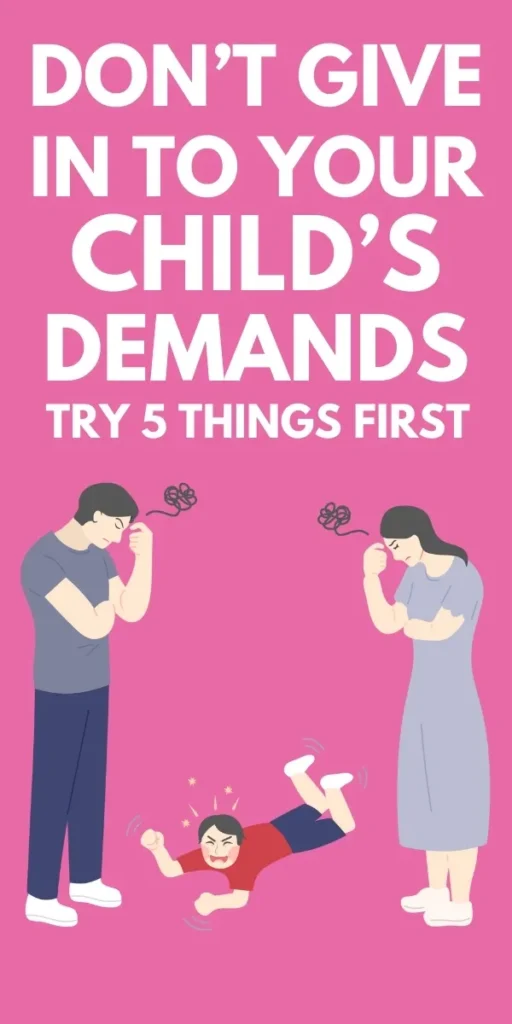Living with a tiny diplomat who negotiates like a pro? “But Mooooommm,” they plead, wielding their most persuasive puppy-dog eyes.
We’ve all been there, on the verge of signing a peace treaty just to avoid another round of negotiations.
But hold on! There’s a better way to navigate these situations. This article is your guide to setting healthy boundaries that work for everyone.
A Guide To Saying No Effectively To Your Child’s Demands
The Importance of Setting Healthy Boundaries

Why Saying “No” Matters
Raising a child is a journey filled with love, laughter, and of course, countless requests.
But sometimes, those requests turn into demands, and you might find yourself questioning whether to give in to keep the peace or hold your ground.
The truth is, setting healthy boundaries with your child is crucial for their development. Here’s why:
- Teaches Self-Regulation:
When you consistently answer “no” to unreasonable demands, it helps your child understand that they can’t always have what they want.
This fosters frustration tolerance and teaches them to manage their emotions in a healthy way.
- Develops Respect for Rules:
By setting clear boundaries, you establish a foundation of respect for rules and expectations.
This translates to better behavior at home, school, and other social settings.
- Boosts Confidence:
Learning to cope with disappointment is a valuable life skill. When your child navigates challenges without getting everything they desire, it builds their confidence and resilience.
- Stronger Parent-Child Bond:
Saying “no” doesn’t make you a bad parent; it shows you care enough to guide your child towards responsible behavior.
Consistent boundaries create a sense of security and trust within the parent-child relationship.
Now you might be wondering, “How do I actually say no without starting a meltdown?”
Don’t worry, I have some practical tips to help you navigate these situations effectively.
6 Strategies for Saying “No” Effectively (And setting boundaries)

The key to setting boundaries is consistency and clear communication. Here are some practical strategies you can use:
1. “I” Statements: The Power of “I”
Instead of getting caught in a blame game, use “I” statements to express your feelings and position clearly.
This avoids putting your child on the defensive and fosters a more productive conversation.
- Example: Instead of saying, “You always want things your way! We can’t have ice cream for breakfast!” try, “I understand you love ice cream, but breakfast is for healthy foods that give us energy. How about we save ice cream for a special treat after dinner?”
2. The Art of the Alternative:
Acknowledge your child’s desire while offering a different, acceptable option.
This validates their feelings and provides a path forward that respects your boundaries.
- Example: “No, you can’t play with my phone right now. It’s very fragile. Would you like to build a tower with your blocks instead? We can even make a pretend phone for your tower!”
3. Setting Clear Limits: The Importance of “Beforehand”
Don’t wait for the moment of demand to decide your response. Decide what your boundaries are beforehand and communicate them clearly.
This eliminates confusion and prevents meltdowns when your answer is “no.”
- Example: Before a trip to the grocery store, establish expectations. “We’re going to the store for milk and bread today. You can’t have any candy, but after dinner, we can pick out a new book together!”
4. Validation is Key: Acknowledging Their Feelings
Let your child know their emotions are valid, even if you can’t fulfill their request.
This shows empathy and helps them process their disappointment in a healthy way.
- Example: “I know you’re really bummed you can’t stay up past bedtime. It’s frustrating to miss out on playtime sometimes. How about we read an extra story before bed tonight?”
5. Following Through: Consistency is King (or Queen)
Sticking to your points is crucial. Once you say no, don’t give in to tantrums or pleas.
Giving in teaches your child that persistence pays off, which can undermine your boundaries in the long run.
- Example: Your child throws a tantrum because they can’t have another cookie. Remain calm, avoid yelling, and offer comfort. Explain that you already said no and suggest an alternative activity they can enjoy.
6. Distraction is Your Friend: Especially for Younger Children
For younger children who might struggle with initial disappointment, distraction can be a powerful tool.
Divert their attention to a different activity they enjoy. This helps them move on from the “no” and prevents the situation from escalating.
- Example: Your toddler is demanding a toy at the store. Instead of getting into a power struggle, point out something exciting in another aisle, like a display of stuffed animals. This can shift their focus and provide a welcome distraction.

Frequently Asked Questions about Setting Boundaries
What if My Child Throws a Tantrum?
How Do I Deal with Guilt When I Say No?
What if My Partner and I Disagree on Boundaries?
Won’t My Child Resent Me if I Say No All the Time?
Conclusion
Boundaries are not a destination, they are a journey. Create a joyful and healthy home environment for the child and yourself by implementing these strategies. Making it a regular habit will yield the finest effects.